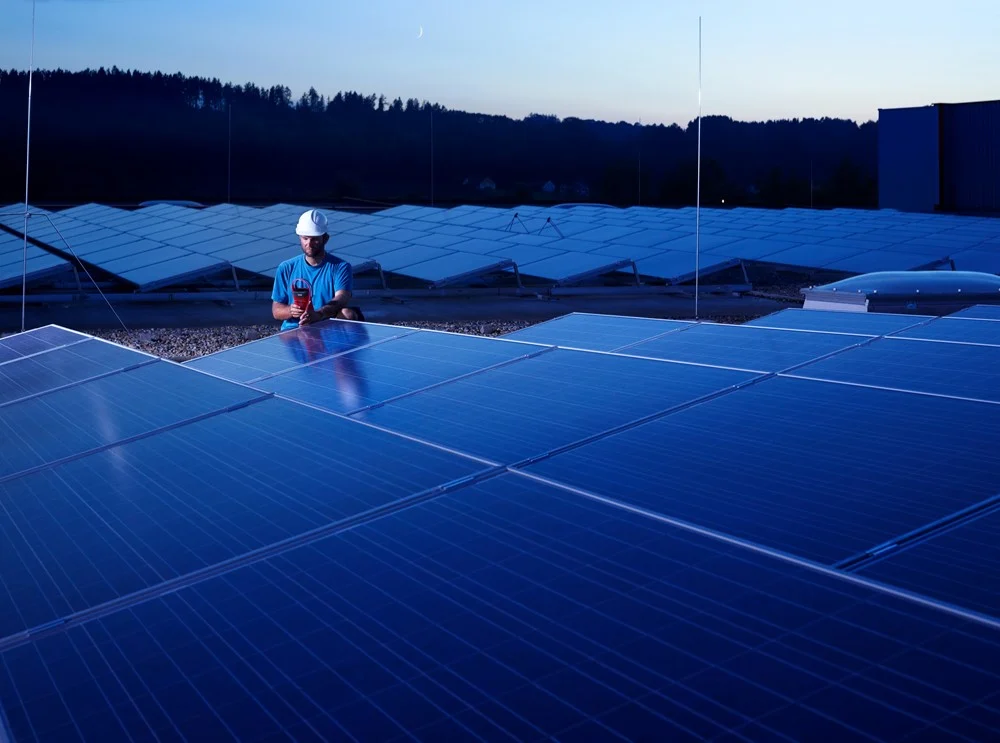New technologies, plummeting costs and our own changing behaviours all promise progress – just don’t expect it to come in a straight line argues Calum Holt.
In the 1930s, the American engineer Theodore Paul Wright made a curious observation about the manufacture of aeroplanes. Mapping the cost of their production over time, he noticed that each time the cumulative number of planes produced doubled, the cost of producing each plane fell by a fixed percentage. That is, the proportional reduction in cost between the 1000th and 2000th plane produced was the same as that between the 2000th and 4000th, the 4000th and 8000th, and so on, the data forming a neat ‘experience curve’, following a power law.
Interestingly, this phenomenon is not unique to aeroplanes. When engineers and economists started looking for it, similar trends were found all over the manufacturing sector, from the production of semiconductors (where Wright’s Law, as it is now known, has mapped falling costs of computing power more accurately than Moore’s Law) to the Ford Model T, the cost of which fell by 15 per cent each time cumulative production doubled.
Such experience curves are also tantalisingly applicable to many technologies at the core of the energy transition, from electric vehicles and solar panels to wind turbines and batteries. It is very likely that such trends will apply to hydrogen electrolysers and carbon capture technology too, though these technologies are still so nascent as not yet to have produced enough reliable data.
Where we do have large data series and can look at costs over long periods, the adherence to the learning rate is extremely high, though the learning rates themselves are often much steeper than those seen in the manufacture of planes or Model Ts. The cost of solar energy, for example, has dropped by some 36 per cent with each doubling of cumulative installed capacity.
But thinking of these curves only as lines on a graph is a mistake. In some ways, an experience curve is a process – one that is self-reinforcing. Cheaper products make customers more likely to adopt a given technology, adoption stimulates greater demand, greater demand leads to higher production volumes, higher production volumes lead to lower unit prices, lower unit prices lead to higher demand, and so on.
By way of example, aeroplanes were once used almost exclusively for mapping enemy positions in the first world war. They could only be afforded only by governments throwing huge sums at any technology which promised to break the deadlock of trench warfare. While it is tragic that it took a war to prove the potential of aviation, the technological improvements and higher production volumes instigated by the conflict paved the way for planes cheap enough to be viable for passengers and express freight.
The same thing happened with semiconductors. While computing power was initially reserved for state intelligence services and NASA programmes with multibillion-dollar budgets, scale and technological improvement eventually made computers mass-marketable to consumers in the late 1970s. The profits from those early PCs led to reinvestment in manufacturing facilities, research and development, and supply chains, which meant cheaper, better PCs, and higher profits in turn when the next generation went on sale. Those profits were reinvested, the process repeated itself, and the rest is history.
Given these past trends, it may be possible to use the development of the digital transition to predict how the energy transition will unfold, given the common economics underlying the respective technologies. Intriguingly, an examination of how things are currently developing in energy markets appears to corroborate many of the prospective parallels. So, what can we learn from history?

For starters, we shouldn’t think of the energy transition as linear. Back in 1980, Bill Gates famously defined success as “a computer on every desk and in every home”. Over 40 years later, there is not in fact a computer in every home (at least not how most people understood ‘computer’ in 1980), but this doesn’t mean that the digital transformation has failed. It is simply that desktop PCs have been superseded by laptops, smartphones, tablets, and wearables. We don’t all need a desktop computer because we have devices in our pocket with literally millions of times more processing power than the 32kg guidance computers that powered the Apollo space missions. Therefore, measured against the targets of 1980, we have simultaneously failed and wildly overachieved.
We should expect these shifting goals to have parallels in the energy transition. The first generation of green energy technologies, such as battery electric vehicles (BEVs), rigid solar photovoltaic (PV) panels, and onshore wind turbines are now cheaper (or close to being cheaper) than fossil fuel equivalents. With plummeting costs and a growing profit incentive from the private market, we should expect an inflection in their deployment now that subsidies, and the accompanying bureaucracy, are superfluous. Though the proliferation of digital devices has exploded since 1980 (again, because it became profitable to sell them widely without subsidies), we should expect the proliferation of green technologies to happen much faster given the existential imperatives involved, the trillion-dollar government budgets set aside for this explicit purpose, and the legal requirement for governments to report their progress on a yearly basis, none of which were there to catalyse the development of computing.
Yet just as desktop PCs were gradually replaced by laptops, tablets and smartphones, so too should we expect BEVs, rigid solar PV panels and onshore windfarms to be replaced in turn by newer, cheaper, more efficient and qualitatively better technologies, many of which are already seeing costs move quickly towards commercial viability. Onshore wind demand will slowly be cannibalised by demand for less obstructive and more efficient floating windfarms, small offshore turbines will be replaced with 20MW giants, short-range BEVs that take all night to charge may be superseded by fuel cell electric vehicles, and even rigid solar panels will likely be phased out eventually in favour of 3D-printed solar film which can be put anywhere and everywhere, further decentralising energy production.
As such, although we often think of the energy transition as a shift from A to B, from 51bn tons of CO2 to net zero, from ‘1990 levels’ to ‘pre-industrial levels’, or even as a ‘race’, implying well-defined starting and finishing lines, this is not a useful way to think about the transition, just as defining digital success by the proportion of homes with desktop PCs is not. Instead, the transition will be more like that undergone by the hypothetical Ship of Theseus, of which every plank and oar was gradually replaced with a stronger, sturdier substitute, until no piece of the original ship remained.
Through this lens, two more parallels with the digital transition can be seen. The first is a continuous deflationary trend as the cost of energy eventually falls, making all goods more accessible to consumers by reducing the costs embedded in their manufacture, distribution, use, and disposal, in a way not dissimilar to that brought about by the emergence of computing since the 1980s, though on a much greater scale.
The second is that, as with the digital transition, it is not simply that we will change our energy use, but that our energy use will change us. The emergence of cheap computing power has altered our behaviours, cultures, and societies, with everything from our dating habits to our attention spans transforming in their wake. If the cost of everything falls with the cost of energy, and this new but pervasive climate-induced anxiety subsides, then we should not only anticipate profound changes to our individual behaviour, but also for this new relationship with energy (and the planet) to result in new businesses, ideas, and cultural habits that are currently either unimaginable or untenable, just as bitcoin or phishing or memes would have been half a century ago. In other words, like the digital transition, this will not simply be a causal or even a reciprocal change, but a dialectical one.
Back in 2022, we’re just starting to see how the first stage of the transition could play out. In 2020, for the first time, most new renewable energy projects were cheaper than the cheapest fossil fuels, and many major economies are now phasing out subsidy programmes because they’re simply no longer needed. The cost of solar electricity has fallen by 90 per cent since 2009, and now represents one of the cheapest forms of energy ever produced.
There will, of course, be obstacles to rolling out wind and solar en masse. Our grids will need substantial investment after almost half a century of neglect, manufacturing supply chains will take time to get into gear, and ensuring that the energy is provided when it is needed will require a buildout of storage infrastructure based on green hydrogen and batteries.

Though the energy transition will not all be plain sailing, wind and solar energy are on a clear trajectory towards being radically better than any other form of energy generation hitherto invented. As we approach a world in which we can easily absorb a fraction of the sun’s energy and with it fulfil even our wildest energy needs, we will also find that we can decarbonise huge swathes of the economy with very little additional technology. Mass-produced electrolysers will provide a cheap source of hydrogen which can power vehicles and heavy machinery, heat homes, be burned in otherwise redundant natural gas plants, and be used as an industrial feedstock. Electrolysis will also give us a cheap and plentiful supply of green oxygen, which carries its own medical and industrial uses, and by pairing these products with carbon capture, we’ll be able to create synthetic hydrocarbons for a variety of uses, including plastics, safe in the knowledge that doing so isn’t damaging the planet, because the carbon involved had to be pulled out of the atmosphere in the first place. Though there will no doubt still be some emissions in 2050, most probably from industries such as concrete manufacture or farming, powering them with green energy means that they will still be less polluting than today. Meanwhile carbon capture technology should be able to mitigate most, if not all, of the adverse effects, while also enabling us to sequester much of the CO2 we continue to spew into the atmosphere today.
If this seems naively utopian, it is worth recalling the miracle of compounding; if the global rate of GDP growth is 3 per cent, then in absolute terms there will be as much economic value created in the next 23 years as there has been in the past 100. That is to say, the difference in ‘development’, in a broad sense between 2045 and today will be as big as that between today and 1922 – an intoxicating thought. Though it is tempting to imagine the new frontier of space or a healthcare revolution brought about by the dawn of genetic sequencing as the main drivers of this growth, the falling cost of energy, and by extension the cost of doing everything, will affect literally every government, business, household, and individual. Only time will reveal the full extent of the impact of the energy transition – though it is sure to be profound.

